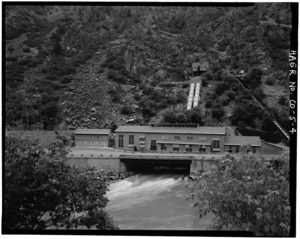Shoshone Generating Station facts for kids

The Shoshone Generating Station is a special power plant in Glenwood Springs, Colorado. It uses the power of water to make electricity. This type of plant is called a hydroelectric power plant. It sits right on the Colorado River.
Besides making power, this plant has very old rights to use water from the Colorado River. These water rights are super important. They help control how much water flows to the western part of Colorado, known as the Western Slope.
Building the Plant
The Shoshone plant was built a long time ago. Construction started in the early 1900s. Its big machines, called turbines, were put in place in 1906. The plant began making electricity in 1909.
How Shoshone Makes Power
The plant can make up to 15 megawatts (MW) of power. It has two large generators, each making 7.5 MW. Usually, it makes about 14 MW of power.
Here's how it works:
- Water is taken from the river at a dam. This dam is about 2 miles (3.2 km) upstream from the plant.
- The water then travels through long tunnels.
- It goes into big pipes called penstocks, which lead down to the power station.
- Inside the station, the water spins the turbines.
- The spinning turbines then power the generators, which create electricity.
- After making power, the water flows back into the Colorado River.
The Shoshone plant is owned and run by a company called Xcel Energy. Even though it's not the biggest power plant, it helps balance the electricity needs in the area.
Important Water Rights
Shoshone has rights to use 1,250 cubic feet (35 cubic meters) of Colorado River water every second. These rights are very old, going back to 1902. This is important because these rights are older than many others. For example, they are older than the rights of cities on Colorado's Front Range. These cities often take water from the Western Slope.
By keeping a steady flow of water downstream, Shoshone helps many parts of the Western Slope. This includes fun river activities, farming, and public water use.
Protecting the Water
Over the years, people have worked to protect Shoshone's water rights.
- In 2007, Xcel Energy and Denver Water made a deal. If water levels were very low during spring snowmelt, Shoshone would use less water. It would use 704 cubic feet (20 cubic meters) per second instead. This was only before the busy summer season for recreation and farming.
- Otherwise, the original 1902 water rights stayed in place.
- In 2016, a new plan called the Shoshone Outage Protocol was signed. This plan made the water rights even stronger. It means the plant keeps its water rights even when it's not making electricity. Before this, if the plant was offline, other water users with lower priority could take the water.
- Historic American Engineering Record (HAER) No. CO-5, "Shoshone Hydroelectric Plant Complex, 60111 U.S. Highway 6, Garfield County, CO", 38 photos, 27 data pages, 4 photo caption pages

